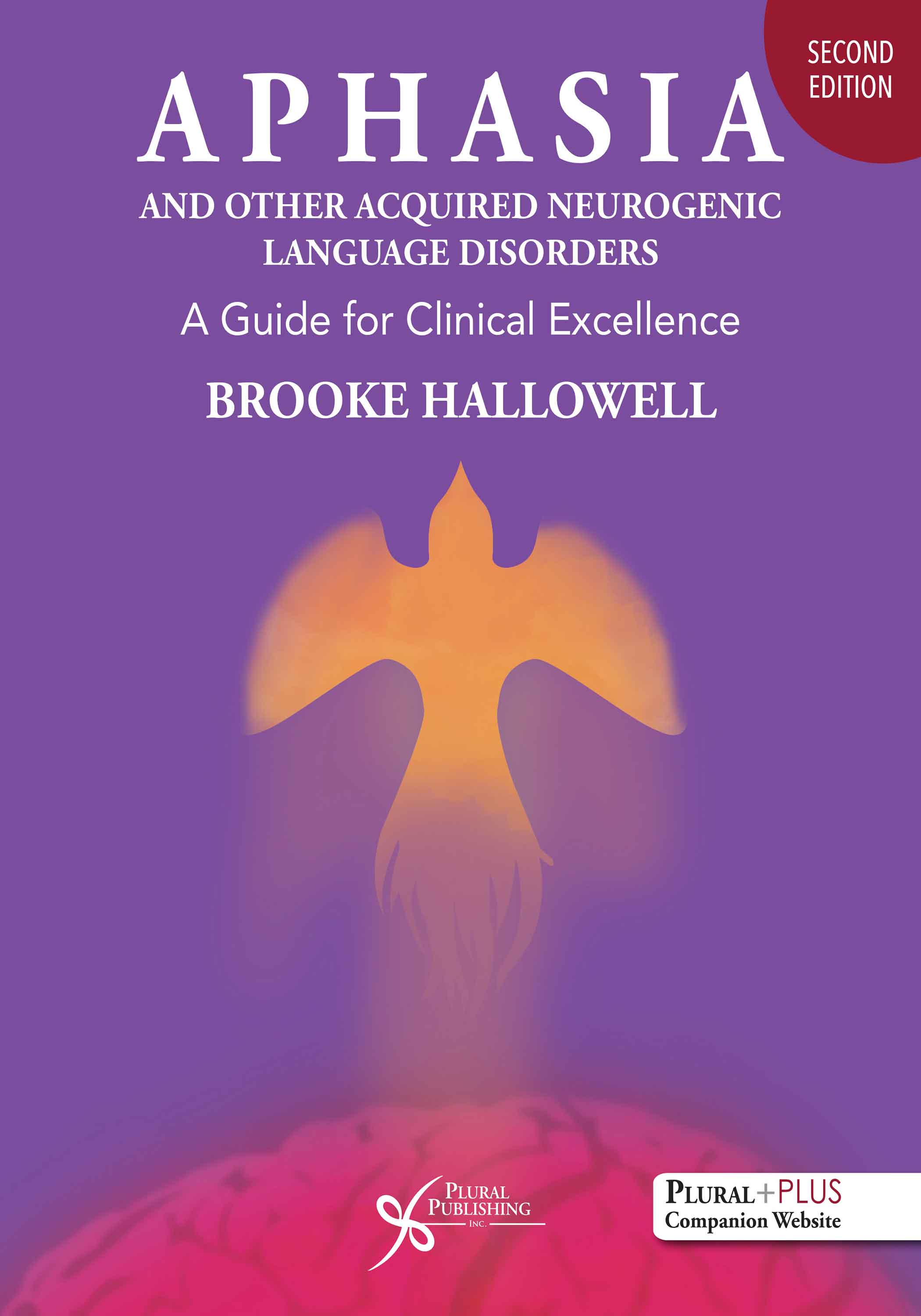
Aphasia and Other Acquired Neurogenic Language Disorders: A Guide for Clinical Excellence
Second Edition
Brooke Hallowell
Details: 629 pages, 2-Color with Full-Color Insert, Softcover, 8.5" x 11"
ISBN13: 978-1-63550-159-9
© 2023 | Available
For Instructors
Purchase
Covering an array of evidence-based content, including aphasia, traumatic brain injury, dementia, and language in aging, Aphasia and Other Acquired Neurogenic Language Disorders: A Guide for Clinical Excellence, Second Edition is a must-have textbook for clinicians and students studying to be speech-language pathologists. This clinical guide strategically addresses scientific foundations, service delivery, international and multicultural perspectives, assessment, and treatment.
Organized to maximize adult learning, the book is adaptable for multiple pedagogic methods for classroom-based courses, independent study, and online learning. The second edition provides clinicians and students a clear pathway for quality and effectiveness in clinical practice.
New to the Second Edition
- Expanded content to reflect important recent developments throughout, with findings from over 500 new studies
- A thoroughly updated chapter on primary progressive aphasia and other neurodegenerative conditions
- Enhanced and updated foci on cognitive-communicative challenges associated with dementia, traumatic brain injury, and right brain injury
- Inclusion of additional voices of people with neurogenic conditions to highlight person-centered strengths and needs
- Updated attention to culturally responsive terminology and content throughout to promote diversity, equity, and inclusion
- Improved information flow based on reviewers’ feedback, while maintaining structure to ease transitions in course design for instructors who used the first edition
- Many new images and illustrations to support learning
- Abundant resources to encourage research collaboration and career development, and to promote supportive networks for people affected by neurogenic communication disorders
- Expanded foci on evidence-based practice, practice-based evidence, participatory research, and implementation science
Key Features
- A rigorous approach to the art and science of clinical practice, integrating diverse theoretical perspectives for a global readership
- Guidance on advocacy, ethics, reimbursement, legal aspects, and counseling
- An emphasis on person-centered, empowering approaches to maximize life participation
- Extensive assessment resources and a process analysis approach for analyzing communicative performance and interpreting assessment results
- How-to content on more than 50 intervention approaches
- Diagrams, charts, illustrations, summary tables, a substantial glossary, a detailed index, and rich up-to-date references
- Content design applying adult learning research to maximize deep learning
- Systematic queries that enliven clear objectives for knowledge, skills/application, and values
PluralPlus Online Ancillary Materials
For instructors: PowerPoint slides, Test bank, Instructor's Guide, Activities/Exercises
For students: Videos, Activities/exercises, Chapter Queries, Study Aids
Reviews
“As we have come to expect from Dr. Hallowell, this is a thoroughly researched book, and an extremely important contribution to the literature on neurogenic communication disorders. Our profession is much the richer for it!”
—Audrey Holland, Ph.D., CCC-SLP, BC-ANCDS, Regents’ Professor Emerita of Speech, Language, and Hearing Sciences, The University of Arizona
“The best and most comprehensive book on aphasia ever published.”
—Darlene Williamson, MA, CCC-SLP, President of the National Aphasia Association and Founder of the Stroke Comeback Center
“This second edition provides an extremely wide knowledge base in the area of aphasia and other acquired neurogenic language disorders. It is the most in-depth book in the area of speech language pathology that I have seen. The website resources are fantastic.
The purpose of this book is to teach readers about body structure and function and give them more skills in assessing and treating clients. It will also help students and other practitioners identify the clients' goals and care for them when dealing with multicultural matters and evidence-based practice. These are worthy objectives that are enforced throughout this book.
The book's table of contents is 18 pages long, covering the book's 33 chapters. The contents section is so detailed that one can only read one chapter at a time. However, each chapter holds a great amount of knowledge that will help readers come away with new information each time.
I was deeply impacted by the information I obtained from reading this book. The content is incredible, with many opportunities for learning during the "Learning and Reflection Activities." I was highly motivated to read at least a portion of each chapter in order to gain insight and to improve my own clinical skills.
This book encourages students, faculty, and speech-language pathologists not only to read assignments, but also to review the book's areas of figures, tables, and first-hand experiences as they go out into the world in their internships and other professional experiences. The various activities are helpful. This book is one that every speech-language pathology student and every speech-language pathologist working in the field should have."
–Lorelei J. Peirson, MA, Biola University, from Doody’s Reviews (August 2022)
What Is Special About This Book?
Acknowledgements
About the Author
Section I. Welcome and Introduction
Chapter 1. Welcome to the Fantastic World of Research and Clinical Practice in Acquired
Neurogenic Communication Disorders
What Are Acquired Cognitive-Linguistic Disorders?
Which Neurogenic Communication Disorders Are Not Acquired Language Disorders?
What Is Clinical Aphasiology?
What Is So Fantastic About the World of Neurogenic Communication Disorders?
We Work With Wonderful People and Become Part of Their Rich Life Stories
We Are Catalysts for Positive Change
We Enjoy Empowerment of Others Through Advocacy and Leadership
We Enjoy a Great Deal of Humor and Fascination
We Enjoy Fantastic Local and Worldwide Professional Networks
Our Work Is Multicultural and Multilingual
We Are Lifelong Learners
We Tap Into Our Most Scientific and Our Most Creative Selves at the Same Time
We Have Rich Career Opportunities
What Disciplines Are Relevant to Aphasia and Related Disorders?
What Is Known About the Incidence and Prevalence of Acquired Neurogenic
Language Disorders?
Where Do Aphasiologists Work?
What Is the Career Outlook for Clinical Aphasiologists?
Learning and Reflection Activities
Chapter 2. Becoming the Ultimate Excellent Clinician
What Makes a Clinician Truly Excellent?
What Can One Do to Become an Excellent Clinical Aphasiologist?
How Do the People We Serve Characterize What They Most Want?
What Are Some Traits of People Who Are Perceived as Unhelpful Clinicians?
What Content Is Important to Master?
What Credentials Are Required for a Career as an Aphasiologist?
What Credentials May Aphasiologists Earn Beyond Their Basic Academic and
Clinical Credentials?
Is It Best to Specialize or Generalize?
What Strategies Help Boost Career Development in Acquired Cognitive-Linguistic
Disorders?
What Organizations Support Professional Information Sharing and Networking
Among Clinical Aphasiologists?
Learning and Reflection Activities
Chapter 3. Writing and Talking About the People With Whom We Work
What Is Important to Consider in Writing and Talking About People With
Neurogenic Cognitive-Linguistic Disorders?
Person-First Language
Alternatives to the Word Patient
People With Disabilities
Research Participants
Older People
Healthy Adults
What Are Important Nuances in Terms We Use to Refer to People Who Care for
People With Neurogenic Cognitive-Linguistic Disorders?
What Is the Difference Between the Terms Therapy and Treatment ?
Neurotypical People
What Are Pros and Cons of Terms Used to Refer to SLPs?
What Are the Preferred Terms When Referring to the Experts Who Work With
People Who Have Neurogenic Communication Challenges?
What Is Important to Keep in Mind Regarding Inclusive and Welcoming Language?
What Other Terms Might Unintentionally Convey Negative Connotations?
Why Are There Inconsistencies in the Prefixes Used in Terms for Characterizing
Neurogenic Symptoms, and What Is the Rationale for Varied Prefix Choices?
Learning and Reflection Activities
Section II. Foundations for Considering Acquired Neurogenic Language Disorders
Chapter 4. Defining and Conceptualizing Aphasia
What Is a Good Way to Define Aphasia?
Aphasia Is Acquired
Aphasia Has a Neurological Cause
Aphasia Affects Reception and Production of Language Across Modalities
Aphasia Is Not a Speech, Intellectual, Sensory, or Psychiatric Disorder
How Have Established Aphasiologists Defined Aphasia?
What Are the Primary Frameworks for Conceptualizing Aphasia?
Unidimensional Frameworks
Multidimensional Frameworks
Medical Frameworks
Cognitive Neuropsychological, Psycholinguistic, and Neurolinguistic Frameworks
Biopsychosocial Frameworks
Social Frameworks
Social Determinants of Health Frameworks
Other Historically Relevant Frameworks
How Does One Choose a Preferred Framework for Conceptualizing Aphasia?
How Are the Frameworks for Conceptualizing Aphasia Relevant to Other
Neurogenic Language Disorders?
Learning and Reflection Activities
Chapter 5. The WHO ICF, Human Rights Perspectives, and Life Participation Approaches
What Is the WHO ICF?
How Is the WHO ICF Relevant to Ethics and Human Rights?
How Is the WHO ICF Specifically Relevant to Intervention and Research in
Rehabilitation?
How Is the WHO ICF Specifically Relevant to People With Neurogenic Language
Disorders?
Learning and Reflection Activities
Chapter 6. Etiologies of Acquired Neurogenic Language Disorders
What Is a Stroke?
What Are Stroke Risk Factors, and What Causes Stroke?
What Are the Physiological Effects of Stroke?
How Crucial Is Timing for Medical Treatment After a Stroke?
How Is the Sudden Onset of Stroke Relevant to Supporting Patients and Families?
What Is a Transient Ischemic Attack?
What Is Hypoperfusion?
What Can Be Done to Prevent Stroke?
Attending to Stroke Triggers
What Is TBI?
What Are Blast Injuries?
What Are Concussion and Mild TBI?
What Can Be Done to Prevent TBI?
What Are Bacteria and Viruses?
What Other Types of Infections Affect Cortical Function?
What Is Neoplasm?
What Is Toxemia?
What Are Diabetes Mellitus and Diabetic Encephalopathy?
What Is Metabolic Syndrome?
What Other Metabolic Disorders Cause Encephalopathy?
What Is Neurodegenerative Disease?
What Is Dementia?
What Is Mild Cognitive Impairment?
What Is Primary Progressive Aphasia?
What Are Some Special Challenges in Identifying Etiologies of Cognitive-Linguistic
Disorders?
Learning and Reflection Activities
Chapter 7. Neurophysiology and Neuropathology of Acquired Neurogenic
Language Disorders
What Should SLPs Know About Neuroanatomy and Neurophysiology Associated
With Neurogenic Cognitive-Linguistic Disorders?
What Are Key Neurophysiological Principles Pertinent to Acquired
Cognitive-Linguistic Disorders?
Specialization of Structure and Function
Interconnectivity Throughout the Brain
The Brain’s Plasticity
What Is the Most Clinically Pertinent Knowledge an Aphasiologist Should Have
About the Blood Supply to the Brain?viii Aphasia and Other Acquired Neurogenic Language Disorders
What Factors Affect a Person’s Prognosis for Recovery From a Stroke or Brain Injury?
Why Is It Important for Clinical Aphasiologists to Know About the Visual System?
What Aspects of the Visual System Are Most Relevant to People With Neurogenic
Language Disorders?
Anatomy and Physiology Associated With Visual Deficits
How Are Visual Field Deficits Characterized?
What Are Ocular Motor Deficits?
What Are Visual Attention Deficits?
What Are Higher-Level Visual Deficits?
What Aspects of the Neurophysiology of Hearing Are Most Relevant to People
With Neurogenic Language Disorders?
Learning and Reflection Activities
Supplemental Review of Neuroanatomy Related to Aphasiology
Supplemental Review of Blood Supply to the Brain
Supplemental Review of the Visual System
Supplemental Review of the Auditory System
Chapter 8. Neuroimaging and Other Neurodiagnostic Instrumentation
What Are the Most Relevant Neuroimaging Techniques for Aphasiologists to
Know About?
Computed Axial Tomography (CAT or CT)
Magnetic Resonance Imaging (MRI)
Single Photon Emission Computed Tomography (SPECT)
Cerebral Angiography
What Other Neurodiagnostic Methods Are Important for Aphasiologists to
Know About?
Electroencephalography (EEG)
Electrocorticography
Additional Methods
Learning and Reflection Activities
Chapter 9. Aging, Which Is Not a Disorder, and Its Relevance to Aphasiology
What Is Aging?
What Are Key Theories About Aging That Are Especially Relevant to Cognition
and Communication?
What Is Aging Well?
How Are Demographic Shifts in Aging Populations Relevant to Clinical
Aphasiologists?
What Are Normal Changes in the Brain as People Age?
What Are Positive Aspects of the Aging Brain?
Memory
Word Finding
Syntactic Processing
Reading and Writing
Discourse
Pragmatics
What Are General Guidelines for Differentiating Normal From Impaired
Language in Older Adults?
What Theories Have Been Proposed to Account for Cognitive-Linguistic Changes
With Aging?
Resource Capacity Theories
Working Memory Theories
Context-Processing Deficiency Theories
Signal Degradation Theories
Transmission Deficit Theories
Speed-of-Processing Theories
Inhibition Theories
What Can Be Done to Ensure the Best Preservation of Language Abilities as
People Age?
What Is Elderspeak, and How May We Raise Awareness About It?
What Sensitivities Related to Ageism Are Important for Aphasiologists to
Demonstrate?
Learning and Reflection Activities
Section III. Features, Symptoms, and Syndromes in the Major Categories of
Cognitive-Linguistic Disorders
Chapter 10. Syndromes and Hallmark Characteristics of Aphasia
How Are the Types of Aphasia Classified?
What Are the Classic Syndromes of Aphasia, and What Are the Hallmark
Characteristics of Each?
Expressive/Receptive, Nonfluent/Fluent, and Anterior/Posterior Dichotomies
Classic Aphasia Classification
Wernicke’s Aphasia
Broca’s Aphasia
Global Aphasia
Conduction Aphasia
Transcortical Sensory Aphasia
Transcortical Motor Aphasia
Mixed Transcortical Aphasia
What Is Primary Progressive Aphasia?
What Other Syndromes of Aphasia Are There, and What Are Their Characteristics?
Crossed Aphasia
Subcortical Aphasia
Anomic Aphasia
How Might Dyslexia and Dysgraphia Be Conceptualized as Symptoms Versus
Syndromes?
What Are Limitations of Classification Systems Based on Relating Function to
Neuroanatomical Structure?
Learning and Reflection Activities
Chapter 11. Cognitive-Communicative Challenges Associated With Traumatic Brain Injury
Why Is It Hard to Generalize About TBI Survivors?
What Communication Symptoms Are Likely to Be Experienced by TBI Survivors
What Are Special Challenges for War- and Terrorism-Related TBI Survivors?
Scope of Practice
Interdisciplinary Collaboration
Assessment Challenges
What Are Special Challenges Faced by TBI Survivors in Health Care Contexts?
What Special Economic Considerations Affect Clinical Work With TBI Survivors?
Learning and Reflection Activities
Chapter 12. Cognitive-Communicative Disorders Associated With Right Hemisphere
Syndrome
What Is Right Hemisphere Syndrome?
How May RHS Affect Communication and Life Participation?
Conversation, Discourse, Pragmatics
Combined Receptive and Expressive Challenges
Receptive Challenges
Expressive Challenges
Attention Deficits
Memory Challenges
Executive Function Challenges
Visual-Perceptual Impairments
Auditory-Perceptual Impairments
Reading and Writing Impairments
What Are Special Challenges That SLPs Face in Serving People With RHS?
Underdiagnosis and Lack of Awareness of RHS
Symptom Classification
Identifying Neurological Structure-Function Relationships
Characterizing What Is Normal
What Are Special Challenges Faced by People With RHS in Health Care Contexts?
Learning and Reflection Activities
Chapter 13. Cognitive-Communicative Disorders in Primary Progressive Aphasia
and Dementia
What Neurodegenerative Conditions Most Commonly Affect Cognitive-Linguistic
Abilities?
What Are General Types of Cognitive-Communicative Impairments in People
With MCI and Dementia?
What Communication Challenges Are Typically Associated With MCI and Dementia?
What Symptoms Are Associated With Common Forms of Dementia?
Alzheimer’s Disease
Vascular Dementia
Dementia With Lewy Bodies (DLB)
Parkinson’s-Associated Dementia
Frontotemporal Dementia (FTD)
Huntington’s Disease
Korsakoff ’s Syndrome
Creutzfeldt-Jakob Disease
AIDS Dementia Complex
What Are Symptoms of the Primary Forms of PPA?
Is There Such a Thing as “Reversible” Dementia?
What Are Implications of an Incorrect Diagnosis of Dementia?
What Is the Role of the SLP in Working With People Who Have PPA and Dementia?
Learning and Reflection Activities
Section IV. Delivering Excellent Services
Chapter 14. Contexts for Providing Excellent Services
What Do SLPs Who Specialize in Neurogenic Communication Disorders Do?
Clinical Intervention (Screening, Assessment, Treatment, Counseling, Educating)
Interprofessional Collaboration and Interdisciplinary Learning
Advocacy
Marketing, Negotiating Contracts, Billing, Recordkeeping, Documentation,
Scheduling and Coordinating Care, Quality Assurance, and Fundraising
Leadership and Management
Research
Teaching and Mentoring
In What Types of Settings Do We Provide Clinical Services?
Hospitals
Rehabilitation Centers
Health Maintenance Organizations
Skilled Nursing and Long-Term Care Facilities
Continuing Care Retirement Communities (CCRCs)
Home Health Agencies
Private Practice and Not-for-Profit Clinics
University-Based Clinics
Adult Day Care Centers
Aphasia Centers
Hospice
In What Ways May Services Be Provided at a Distance?
With What Types of Teams Do Clinical Aphasiologists Engage?
How Do SLPs Get Paid?
Where Does the Money Come From to Pay for SLP Services?
Government-Sponsored Programs
Health Insurance
Private Pay
Mixed Funding Options
Philanthropic Donations
How Do Service-Providing Agencies Get Paid?
What Makes Services Provided by SLPs Reimbursable?
Effective Documentation Meeting All Requirements for Reimbursement
A Physician’s Order
Preauthorization for Services by the Third-Party Payer
Evidence That the Services Are Actually Covered by the Plan
Evidence of the Need for Skilled Services
Confirmation That the Methods Used Are Evidence Based
Documentation of the Life-Affecting Nature of Services
Evidence of Treatment Progress
Good Relationships With Decision Makers at Third-Party Payer Agencies
What Are the Primary Reasons for Which Reimbursements for SLP Services
Are Denied?
What Do We Do if We Are Denied Reimbursement for Our Services?
How Do Health Care Finance and Cost-Control Systems Affect Clinical Services?
What Are the Impacts of Health Care Cost Cutting and Cost Control on Services
for People With Neurogenic Communication Challenges?
Learning and Reflection Activities
Chapter 15. Engaging Proactively in Advocacy and Legal and Ethical Concerns
How May Clinicians and the People We Serve Promote Access to SLP Services and
Communication Support?
Enhance Awareness of Communication as a Human Right
Raise Awareness About Neurogenic Communication Challenges and Ways to
Support People and Loved Ones Coping With Them
Help Educate Professionals in Health Care Contexts
Encourage Referrals
Advocate for Reduced Medicalization of Communication Disabilities
Promote Community-Based Approaches
Expand Knowledge Translation
How Are Human Rights, Morality, Ethics, and Law Relevant to Advocacy for
People With Acquired Neurogenic Disorders of Language and Cognition?
What Is the Role of the SLP in Supporting the Rights of Individuals With Aphasia
and Related Disorders?
How Do SLPs Engage in Decisions Regarding Competence and Decision-Making?
How Might Financial Conflicts of Interest Affect the Practice of Clinical
Aphasiologists?
Learning and Reflection Activities
Chapter 16. Clinical Aphasiology Around the World
What Global Trends Are Affecting the Incidence and Prevalence of Neurogenic
Communication Disorders?
A Rapidly Expanding Aging Population
Ongoing Demographic Shifts
Increasing and Disproportionate Incidence and Prevalence of Conditions That
Cause Neurogenic Communication Disorders
Health Care and Prevention Infrastructure Challenges
Global Health Priorities Undermining Essential Values
What Are Important Priorities for Global Capacity Building to Serve People With
Acquired Neurogenic Communication Disorders?
Build Culturally Contextualized Academic and Clinical Programs
Expand Life Participation Approaches
Attend to Cultural Aspects of Health, Aging, and Disability That May Affect
Receptivity to Services
What Are Key Challenges to Enhancing Global Engagement in Acquired
Neurogenic Communication Disorders?
What Are Important Ethical Considerations for Aphasiologists Engaging in
Transnational Work?
Learning and Reflection Activities
Section V. Strategic and Meaningful Assessment
Chapter 17. Best Practices in Assessment
Where and When Does Assessment Happen?
Assessment Happens Throughout Intervention
Treatment Begins the Moment Assessment Starts
What Are the Purposes of Assessment?
What Aspects of Assessment Are Truly Relevant to Actual Clinical Practice?
What Are the Best Practices in Assessment of Acquired Neurogenic Language
Disorders?
Do Not Underestimate How Impactful Your Role Is
Focus on the Person
Keep the Person at the Center of the Process
Focus on Life Participation Goals From the Start
Focus on Strengths
Have a Clear Purpose
Ensure the Best Possible Assessment Conditions
Be Strategic in Setting the Location
Be Strategic About Timing
Include Others in the Process
Be Mindful of Multiple Perspectives on Real-Life Impacts of Communication
Disability
Speak Directly to the Person
Collaborate
Appreciate That Experts, Not Tests, Are What Determine Diagnoses
Attend to Cultural and Linguistic Differences
Learning and Reflection Activities
Chapter 18. Psychometrics of Assessment and Components of Assessment Processes
What Psychometric Properties Should Be Addressed in Assessment Processes?
What Are Potentially Confounding Factors?
Factors Related to Concomitant Challenges to Health and Well-Being
Test Design Factors
Assessment Context Factors
Interpersonal Factors
What Is Entailed in Screening for Acquired Neurogenic Language Disorders?
What Are the Typical Components of a Comprehensive Assessment Process?
What Information Is Pertinent to Collect During the Case History?
Learning and Reflection Activities
Chapter 19. Problem-Solving Approaches to Differential Diagnosis and
Confounding Factors
How Are Potentially Confounding Factors Relevant to Differential Diagnosis?
What Are Important Potentially Confounding Factors in Language Assessment,
and How Do We Address Them?
Age
Intelligence, Literacy, and Education
Visual Problems
Hearing Problems
Motor Challenges
Reading Problems
Dysgraphia and Other Writing Deficits
Problems of Awareness and Arousal
Attention Problems
Lack of Awareness of Deficits
Executive Function Deficits
Pragmatic Deficits
Memory Problems
Other Concomitant Cognitive and Linguistic Deficits
Depression and Other Mood Disorders
Anxiety
Emotional Lability
Other Challenges to Health and Well-Being
How Does a Process Analysis Approach to Assessment Help Address Potentially
Confounding Factors?
Learning and Reflection Activities
Chapter 20. Tests, Scales, and Screening Instruments
What Are the Most Important Factors in Selecting an Assessment Instrument?
What Is the Reason for Your Assessment?
Who, Specifically, Is Being Assessed?
Does It Provide an Appropriate Index of the Constructs You Wish to Assess?
Does the Tool Allow for Alternative Response Modes in Cases Where Clients May Have
Trouble With Traditional Response Modes?
Might Instructions and Tasks Involved Confound Results?
What Is the Quality of a Given Tool?
Is It Up to Date and Appropriate in Terms of Content?
Does the Tool Complement Your Own Preferences and Preferred Theoretical
Frameworks?
How Practical Is the Tool Under Consideration?
Do Others on Your Rehabilitation Team Understand the Results You Report and
Your Interpretation of Them?
What Are the Most Important Factors in Evaluating Assessment Instruments?
What Assessment Tools Are Available?
Learning and Reflection Activities
Chapter 21. Discourse and Conversation as Vital Aspects of Assessment
What Is Discourse?
What Are General Categories, Types, or Genres of Discourse?
What Is Conversational or Discourse Analysis?
Why Is Discourse Sampling and Analysis Important?
Discourse, Especially the Social Use of Language, Is Highly Relevant to Every
Type of Acquired Neurogenic Disorder
Discourse Analysis Helps Determine Strengths and Weaknesses Not Evident
Through Other Forms of Assessment
Discourse Analysis May Yield Critical Information for Differential Diagnosis
Discourse Analysis Is Vital to Treatment Planning
Discourse Analysis Is an Essential Aspect of Research
What Are Key Strategies for Sampling Discourse?
What Are Key Measures for Indexing Discourse Competence?
What Are Best Practices in Interpreting Discourse Analysis Results?
What Challenges Do Aphasiologists Face in Applying Discourse Analysis in
Clinical Practice and Research?
Time
Training and Mentorship
Equipment and Software
Clear Communication and Perceived Relevance
Replicability and Variability in the Evidence Base
How May Aphasiologists Confront Challenges in Applying Discourse Analysis in
Clinical Practice and Research?
Learning and Reflection Activities
Chapter 22. Documenting Assessment Results and Considering Prognosis
What Are Best Practices in Sharing Assessment Results With Adults Who
Have Acquired Cognitive-Linguistic Disorders and the People Who Care
About Them?
How Do We Best Make Judgments About Prognosis?
What Are Best Practices for Reporting Assessment Results in Writing?
What Information Is Typically Included in Assessment Reports?
What Abbreviations Are Commonly Used in Clinical Reporting?
Learning and Reflection Activities
Section VI. Theories and Best Practices in Intervention
Chapter 23. Best Practices in Intervention
What Are the Best Practices in the Treatment of Neurogenic Language Disorders?
Embrace Communication as a Human Right
Recognize Assessment as an Ongoing Intervention Process
Be Person Centered
Include Family Members, Caregivers, and Others Whose Roles Are Relevant
Have a Clear Sense of Purpose and Goals
Engage Communication Partners Outside of the Client’s Immediate Circle of
Friends and Family
Embrace Cultural and Linguistic Differences
Encourage Self-Coaching
Consider Optimal Timing
Consider Optimal Locations and Conditions
Focus on Functional Communication
Engage the Person Actively and Meaningfully in Goal Setting
Focus on Relevant Material
Focus on Strengths
Be an Interprofessional Team Player
Integrate Evidence-Based Practice With Practice-Based Evidence
Blend Art With Science
Encourage Aphasia-Friendly Communication
Attend to Behavioral Challenges That Impede Successful Interactions
What Does the Excellent Clinical Aphasiologist Know About Evidence-Based
Practice?
Where Can We Find Pertinent Information to Support Evidence-Based Practice?
How Does the Excellent Clinician Integrate Evidence-Based Practice With
Practice-Based Evidence?
How May Excellent Clinicians Support Knowledge Translation Through
Implementation and Systems Science?
Learning and Reflection Activities
Chapter 24. Treatment Theories and Types of Treatment to Enhance Language and
Cognition Across All People With Neurogenic Communication Challenges
What Are the Purposes of Treatment Methods?
What Are the Mechanisms of Recovery After Stroke and Brain Injury?
How May Behavioral Treatment Facilitate Brain Recovery?
How May Pharmacological Agents Facilitate Brain Changes?
How May Brain Stimulation Facilitate Brain Changes?
What Other Types of Intervention May Facilitate Brain Changes?
Can We Differentiate Spontaneous Recovery From Progress Made Through
Treatment?
What Are the Optimal Times During Recovery to Initiate Treatment?
What Is the Optimal Focus of Initial Treatment Soon After a Stroke or Brain Injury?
Focus on Communication Needs
Counsel and Share Information
Promote Rest
Consider the Balance of Compensatory With Restitutive Approaches
Consider Pros and Cons of Focusing on Attention
What Is the Optimal Intensity and Duration of Treatment?
What Is the Best Level of Complexity for Treatment Foci?
What Other Treatment Parameters Are Important to Consider?
How Might Intervention in Neurodegenerative Conditions Slow
Cognitive-Linguistic Decline?
What Is the Best Time to Initiate Treatment With People Who Have
Neurodegenerative Conditions?
Learning and Reflection Activities
Section VII. General Approaches to Treatment
Chapter 25. General Approaches for Enhancing Cognitive-Linguistic Abilities in
Traumatic Brain Injury, Stroke Survivors, and People With Primary
Progressive Aphasia and Dementia
What Is Treatment Fidelity, and How Is It Relevant to Clinical Aphasiology?
What General Social and Life Participation Approaches Are Applicable to Treatment?
Life Participation Approach to Aphasia
Supported Communication
What General Treatment Methods Fit Within Social and Life Participation Models?
Total Communication Approaches
Partner and Caregiver Training
Reciprocal Scaffolding
Workplace Immersion Programs
Aphasia Mentoring Programs
Toastmaster Programs
Humor as Therapy
Online Games
Other Socially Focused Programs
What General Cognitive Neuropsychological Approaches Are Applicable to
Treatment?
What Is Cognitive Rehabilitation?
What Is the Stimulation-Facilitation Approach?
How May Group Treatment Be Implemented, and How Can It Help People With
Aphasia and Related Disorders?
How May AAC, Apps, and Software Be Used to Support Communication and Aid
in Treatment?
Alternative and Augmentative Communications
What Are Intensive and Residential Aphasia Programs, and How Can They Help
People With Aphasia and Related Disorders?
Learning and Reflection Activities
Chapter 26. Facilitating Communication in People With Primary Progressive Aphasia
and Dementia
What Are Special Service Delivery Challenges for Serving People With PPA and
Dementia?
How Is Working With People Who Have PPA and Dementia Recognized as a
Component of the SLP’s Scope of Practice?
What SLP Services for People With Dementia Are Reimbursable?
What Types of Direct Treatment May Help People With PPA and Dementia?
What Are Important Approaches for Caregiver Coaching, Training, and Support?
What Are Memory Books and Memory Wallets, and How Are They Implemented?
What Is Spaced Retrieval Training, and How Is It Implemented?
What Is the FOCUSED Program, and How Is It Implemented?
What Are Montessori Approaches to Dementia Management?
What Are Additional Forms of Programming to Support People With PPA and
Dementia?
In What Other Ways May Clinical Aphasiologists Professionally Support the
Communication Needs of People With PPA and Dementia and the People
Who Care About Them?
Learning and Reflection Activities
Chapter 27. Counseling and Life Coaching
How Might an SLP Become an Effective Counselor and Coach?
Is the SLP Working With Adults to Be a Counselor, Life Coach, or Both?
What Are Important Considerations Related to Counseling and Scope of Practice?
How Might a Speech-Language Clinician Adopt a Counseling Mindset?
How Does a Clinician Listen and Respond Empathetically and Compassionately?
How Do We Promote a Positive Outlook Without Conveying a Pollyanna Attitude?
How Might Multicultural Differences Affect Counseling and Coaching?
How Might Counseling Moments Be Influenced by the Time Course of Recovery
and Intervention?
Counseling Following a Traumatic Change
Counseling at the Start of Intervention
Counseling Related to Assessment Results and Sharing Prognosis
Counseling During Treatment
Counseling at Discharge
How May Coaching Enhance Self-Advocacy?
What Are Best Practices in Responding to Seemingly Misguided Statements?
What Are Effective Ways to Address Emotional Lability During Clinical Interactions?
What Is the Role of the SLP in Addressing Depression in People With Neurogenic
Communication Disorders?
How Can Communication Counseling Enhance End-of-Life Care?
What Are Ways in Which Opportunities for Counseling Can Be Missed?
How Might Some Aspects of Life Improve After Onset of an Acquired Neurogenic
Communication Disorder?
How May People With Acquired Communication Challenges Support One Another?
What Are Some Helpful Information-Sharing Strategies and Resources?
Learning and Reflection Activities
Chapter 28. Complementary and Integrative Approaches
What Are Complementary and Integrative Approaches to Wellness?
How Are Complementary and Integrative Approaches Relevant to Neurogenic
Disorders of Language and Cognition?
Why Is It Important for Clinical Aphasiologists to Learn About Complementary
and Integrative Approaches?
How Are Mind-Body Practices Relevant to People With Cognitive-Linguistic
Challenges?
How Might Hypnosis and Visualization Be Relevant to People With Neurogenic
Communication Disorders?
What Are the Potential Roles of Religion and Spirituality in Acquired Neurogenic
Communication Disorders?
How Might Natural Product Use Be Relevant to People With Cognitive-Linguistic
Challenges?
Why Are Complementary and Integrative Approaches Increasing in Popularity?
Frustration With Current Options
Increasing Awareness
Expanded Funding
Increasing Evidence
Aggressive Marketing
What Is the Status of the Evidence Base Supporting Alternative Approaches to
Improving Cognitive-Communicative Abilities?
How Might SLPs Support People Considering Complementary and Alternative
Approaches to Cognitive-Communicative Wellness?
Stay Within Your Scope of Practice
Engage Only in Methods You Are Trained in and Competent to Carry Out
Emphasize Complementary Over Alternative Approaches to Direct Intervention for
Communication and Cognition
Keep an Open, Nonjudgmental Attitude and Appreciate Multicultural Differences
Encourage Caution When Counseling People Considering Alternative and
Complementary Approaches
Learning and Reflection Activities
Section VIII. Specific Treatment Approaches
Chapter 29. Specific Approaches for Promoting Compensatory Communication Strategies
What Is Promoting Aphasics’ Communicative Effectiveness (PACE)?
On What Principles Is PACE Treatment Based?
How Is PACE Treatment Implemented?
What Is the Status of PACE in Terms of Evidence-Based Practice?
What Is the Communicative Drawing Program?
On What Principles Is CDP Based?
How Is CDP Implemented?
What Is the Status of the CDP in Terms of Evidence-Based Practice?
What Is Back to the Drawing Board?
On What Principles Is BDB Treatment Based?
How Is BDB Implemented?
What Is the Status of BDB in Terms of Evidence-Based Practice?
What Is Visual Action Therapy?
On What Principles Is VAT Treatment Based?
How Is VAT Implemented?
What Is the Status of VAT in Terms of Evidence-Based Practice?
Learning and Reflection Activities
Chapter 30. Specific Approaches for Enhancing Expressive Language
What Is Constraint-Induced Language Therapy?
On What Principles Is CILT Based?
How Is CILT Implemented?
What Is the Status of CILT in Terms of Evidence-Based Practice?
What Is Script Training?
On What Principles Is Script Training Based?
How Is Script Training Implemented?
What Is the Status of Script Training in Terms of Evidence-Based Practice?
What Is Melodic Intonation Therapy?
On What Principles Is MIT Based?
How Is MIT Implemented?
Level I
Level II
Level III
Level IV
What Is the Status of MIT in Terms of Evidence-Based Practice?
What Is Voluntary Control of Involuntary Utterances?
On What Principles Is VCIU Treatment Based?
How Is VCIU Implemented?
What Is the Status of VCIU in Terms of Evidence-Based Practice?
What Is Response Elaboration Training?
On What Principles Is RET Based?
How Is RET Implemented?
What Is the Status of RET in Terms of Evidence-Based Practice?
What Is Treatment for Aphasic Perseveration?
On What Principles Is TAP Based?
How Is TAP Implemented?
What Is the Status of TAP in Terms of Evidence-Based Practice?
Learning and Reflection Activities
Chapter 31. Specific Approaches for Improving Word Finding and Lexical Processing
What Are Cueing Hierarchies for the Treatment of Anomia?
On What Principles Are Cueing Hierarchies for the Treatment of Anomia Based?
How Is Cueing Hierarchy Treatment Implemented?
What Is the Status of Cueing Hierarchies for the Treatment of Anomia in Terms of
Evidence-Based Practice?
What Is Semantic Feature Analysis?
On What Principles Is SFA Treatment Based?
How Is SFA Treatment Implemented?
Baseline Phase and Target Selection
Semantic Feature Analysis Chart Method
Graphic Organizer Method
What Is the Status of SFA in Terms of Evidence-Based Practice?
What Is Phonological Components Analysis?
On What Principles Is PCA Treatment Based?
How Is PCA Treatment Implemented?
What Is the Status of PCA in Terms of Evidence-Based Practice?
What Is Verb Network Strengthening Treatment?
On What Principles Is VNeST Based?
How Is VNeST Implemented?
Baseline
Stimulus Selection and Creation
Generation of Agent-Patient Pairs
Wh- Questions About Agent-Patient Pairs
Semantic Judgments
Generation of Agent-Patient Pairs Again
What Is the Status of VNeST in Terms of Evidence-Based Practice?
What Is Verb as Core?
On What Principles Is VAC Treatment Based?
How Is VAC Treatment Implemented?
What Is the Status of VAC in Terms of Evidence-Based Practice?
Learning and Reflection Activities
Chapter 32. Specific Approaches for Improving Syntax
What Is Treatment of Underlying Forms?
On What Principles Is TUF Based?
How Is TUF Implemented?
Ensuring Metalinguistic Awareness
Creating Noncanonical Sentences
Thematic Role Training
Practice
What Is the Status of TUF in Terms of Evidence-Based Practice?
What Is Mapping Therapy?
On What Principles Is Mapping Therapy Based?
How Is Mapping Therapy Implemented?
What Is the Status of Mapping Therapy in Terms of Evidence-Based Practice?
What Is the Sentence Production Program for Aphasia?
On What Principles Is SPPA Treatment Based?
How Is SPPA Implemented?
What Is the Status of SPPA and HELPSS in Terms of Evidence-Based Practice?
Learning and Reflection Activities
Chapter 33. Specific Approaches for Improving Reading and Writing
What Are Basic Principles That Underlie Most Writing- and Reading-Focused
Programs for People With Aphasia?
What Is Copy and Recall Treatment?
On What Principles Is CART Based?
How Is CART Implemented?
What Is the Status of CART in Terms of Evidence-Based Practice?
What Is Anagram and Copy Treatment?
On What Principle Is ACT Based?
How Is ACT Implemented?
What Is the Status of ACT in Terms of Evidence-Based Practice?
What Is the Problem-Solving Approach?
On What Principles Is the Problem-Solving Approach Based?
How Is the Problem-Solving Approach Implemented?
What Is the Status of the Problem-Solving Approach in Terms of Evidence-Based
Practice?
What Is Multiple Oral Rereading?
On What Principles Is MOR Treatment Based?
How Is MOR Implemented?
What Is the Status of MOR in Terms of Evidence-Based Practice?
What Is Oral Reading for Language in Aphasia?
On What Principles Is ORLA Treatment Based?
How Is ORLA Treatment Implemented?
What Is the Status of ORLA in Terms of Evidence-Based Practice?
Learning and Reflection Activities
Epilogue
Glossary
References
Index
Aphasia and Other Acquired Neurogenic Language Disorders: A Guide for Clinical Excellence, Second Edition comes with access to supplementary student and instructor materials on a PluralPlus companion website.
STUDENTS:
To access the student* materials, you must register the access code printed on the inside front cover of your print book on the companion website.
INSTRUCTORS:
To access the instructor materials, you must contact Plural Publishing, Inc. to be verified as an instructor and receive your access code.
Email: instructormaterials@pluralpublishing.com
Tel: 866-758-7251 (toll free) or 858-492-1555
*Note for students: If you have purchased this textbook used or have rented it, your access code will not work if it was already redeemed by the original buyer of the book. Plural Publishing does not offer replacement access codes for used or rented textbooks.
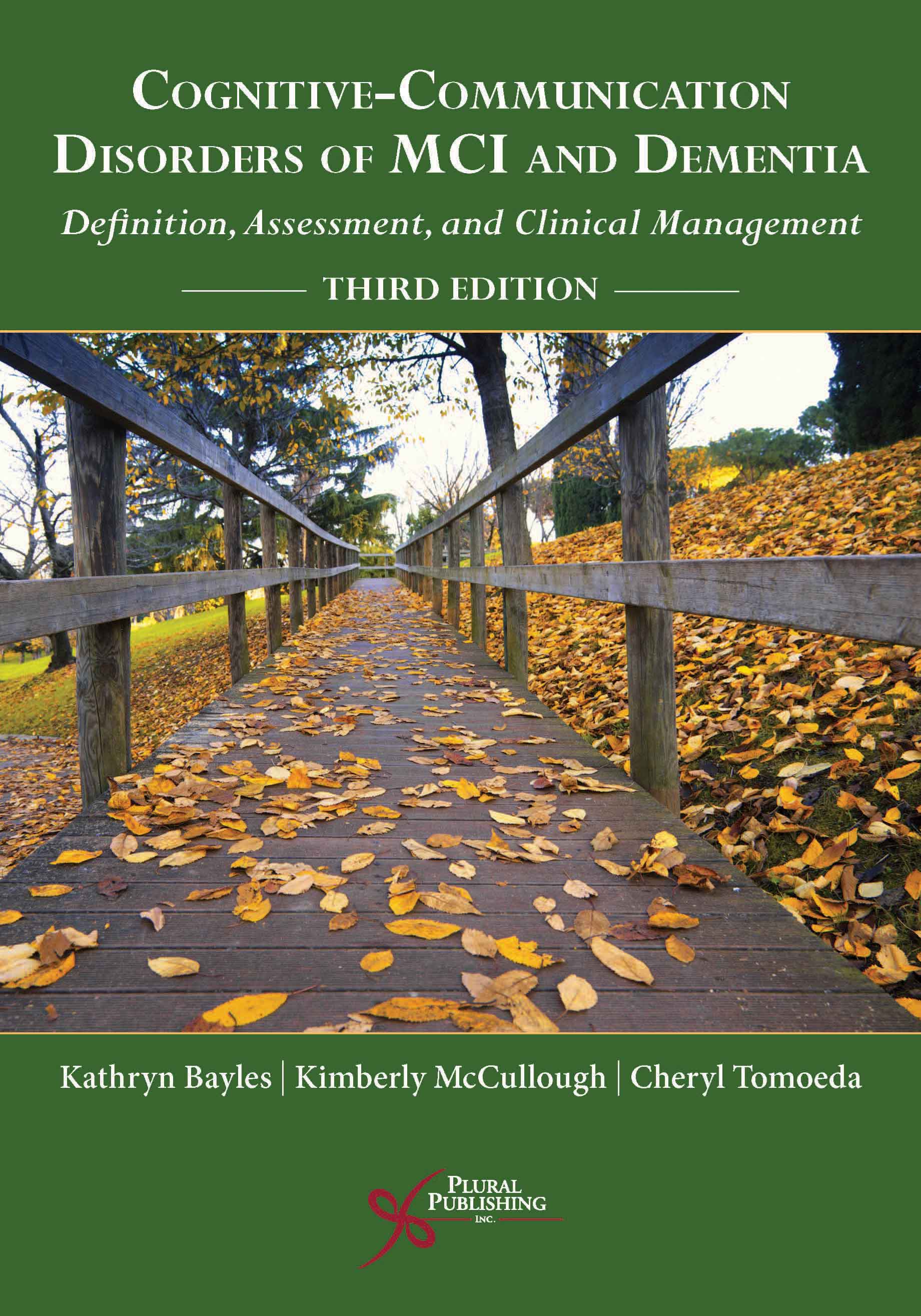
Cognitive-Communication Disorders of MCI and Dementia: Definition, Assessment, and Clinical Management
Third Edition
Kathryn Bayles, Kimberly McCullough, Cheryl K. Tomoeda
Details: 265 pages, B&W, Softcover, 7" x 10"
ISBN13: 978-1-63550-060-8
© 2020 | Available
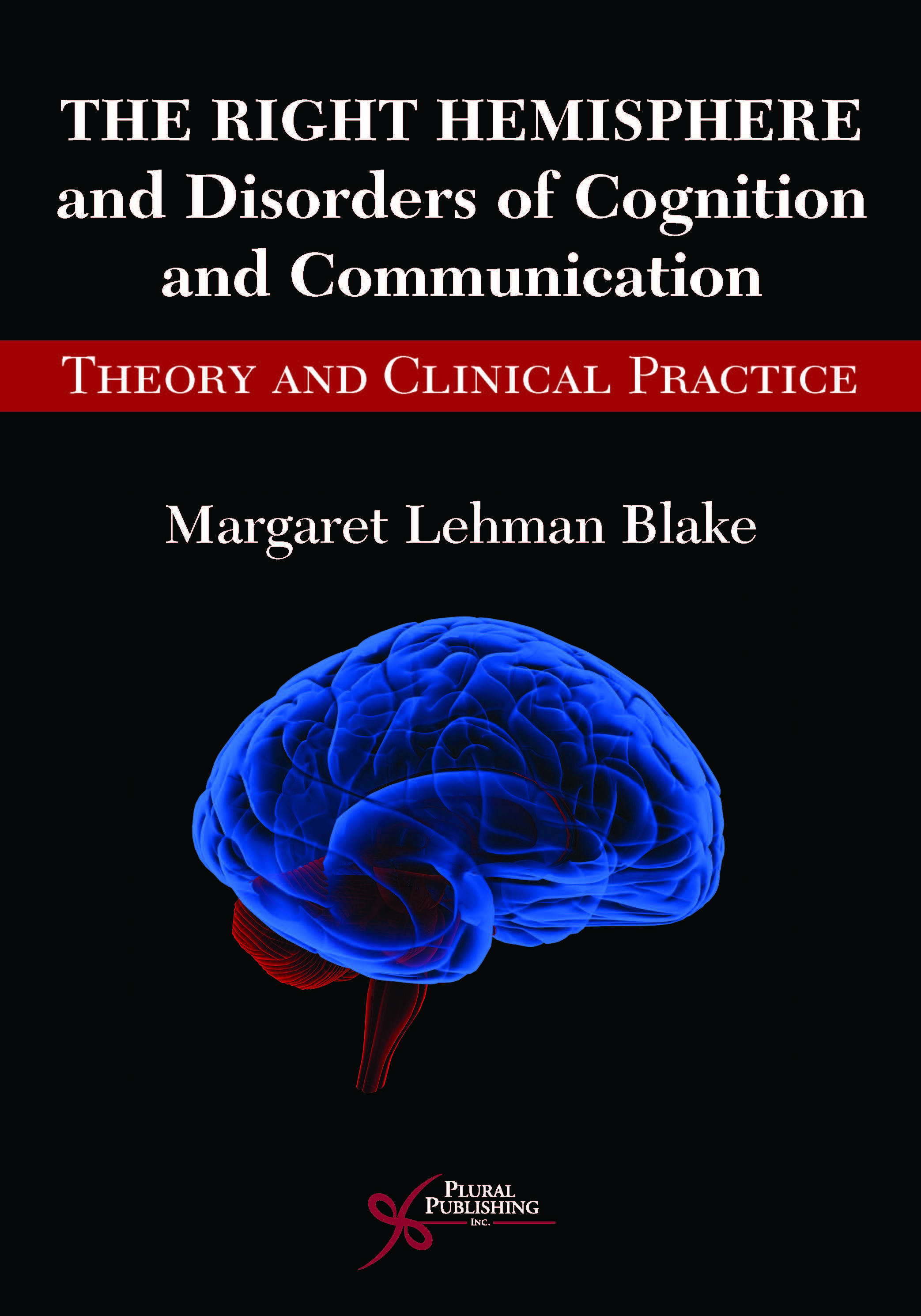
The Right Hemisphere and Disorders of Cognition and Communication: Theory and Clinical Practice
First Edition
Margaret Lehman Blake
Details: 301 pages, B&W, Softcover, 7" x 10"
ISBN13: 978-1-59756-962-0
© 2018 | Available
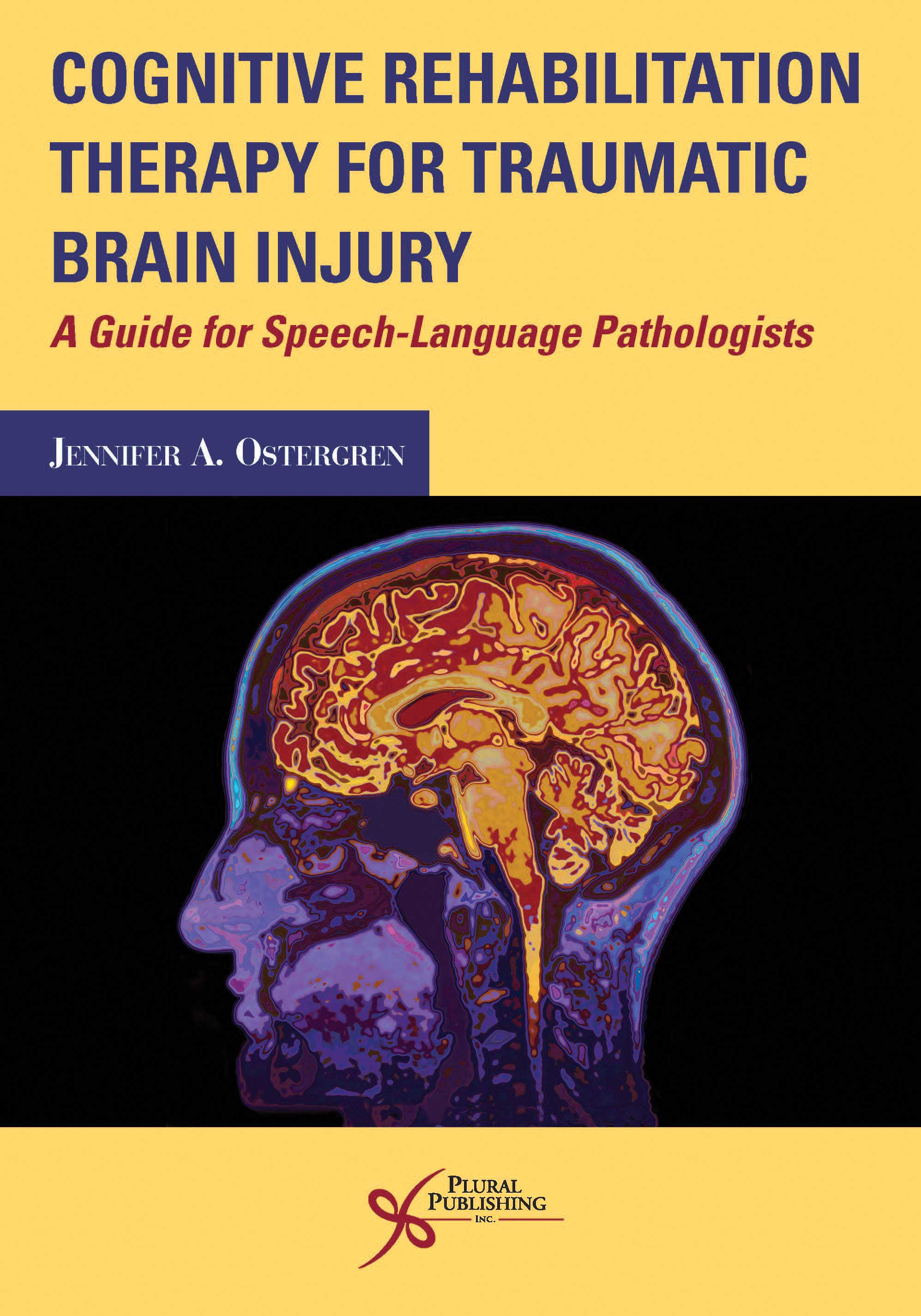
Cognitive Rehabilitation Therapy for Traumatic Brain Injury: A Guide for Speech-Language Pathologists
First Edition
Jennifer A. Ostergren
Details: 321 pages, B&W, Softcover, 7" x 10"
ISBN13: 978-1-59756-789-3
© 2018 | Available
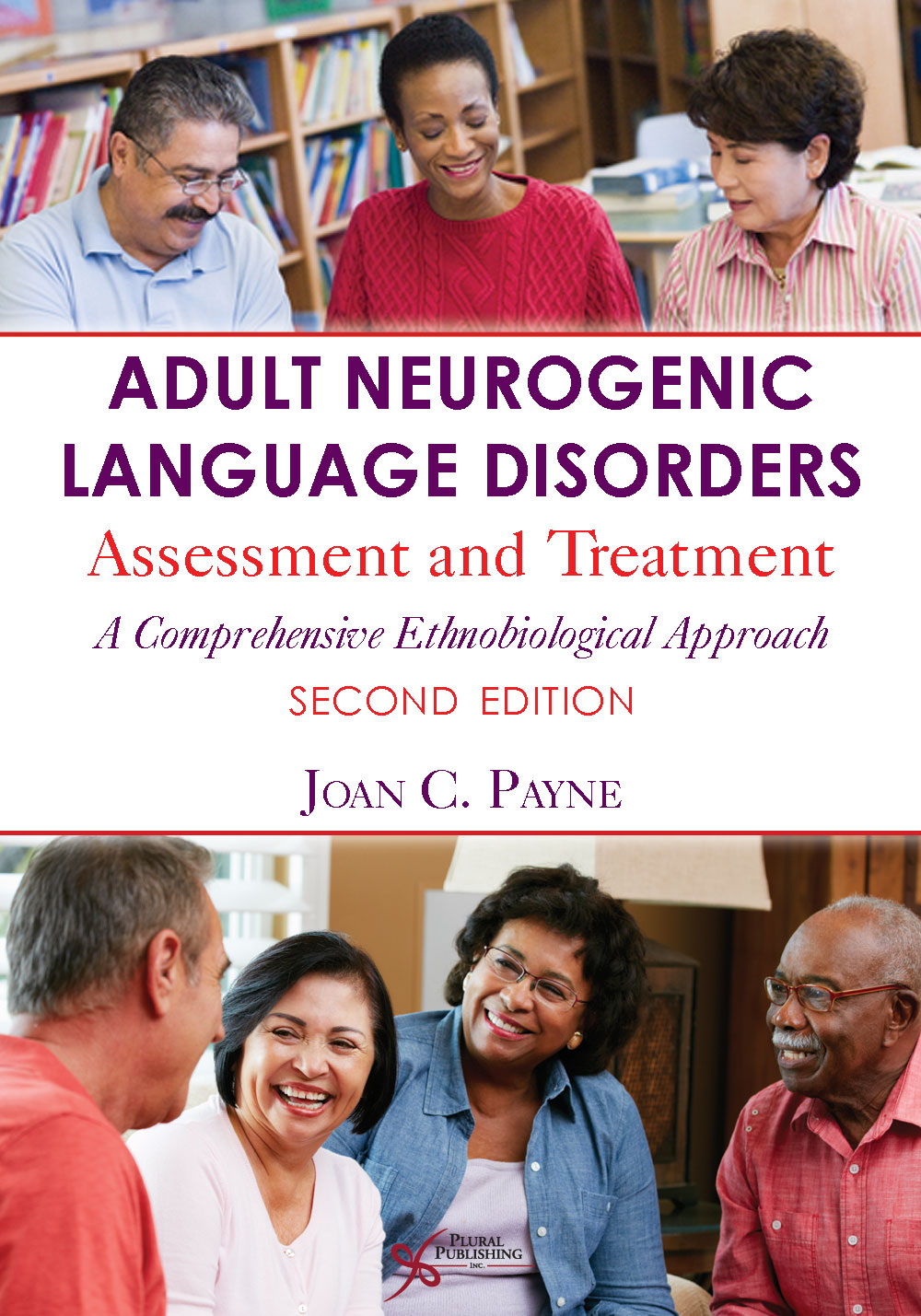
Adult Neurogenic Language Disorders: Assessment and Treatment. A Comprehensive Ethnobiological Approach
Second Edition
Joan C. Payne
Details: 392 pages, B&W, Softcover, 7" x 10"
ISBN13: 978-1-59756-503-5
© 2014 | Available
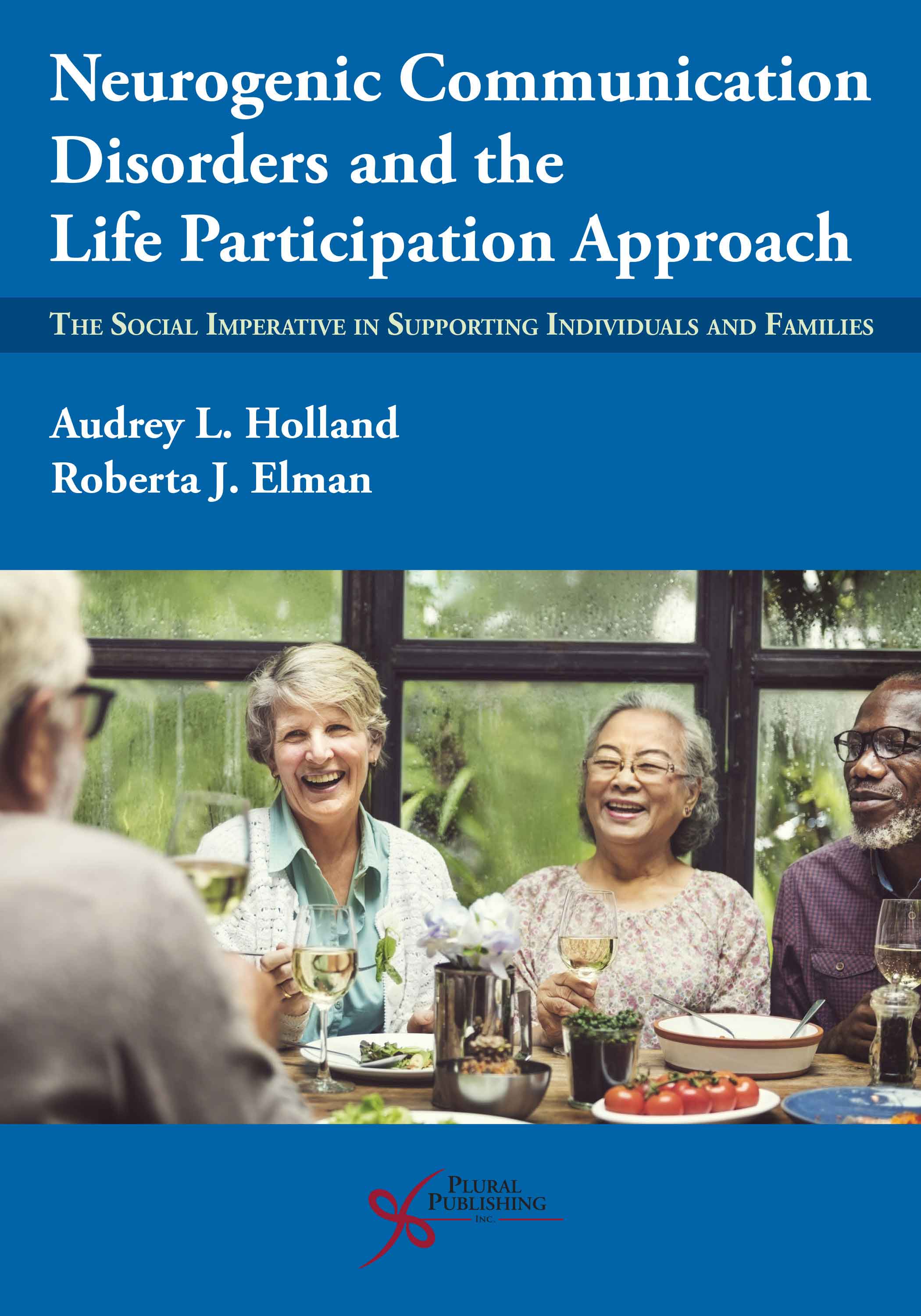
Neurogenic Communication Disorders and the Life Participation Approach: The Social Imperative in Supporting Individuals and Families
First Edition
Audrey L. Holland, Roberta J. Elman
Details: 242 pages, Softcover, B&W, 6" x 9"
ISBN13: 978-1-63550-295-4
© 2021 | Available
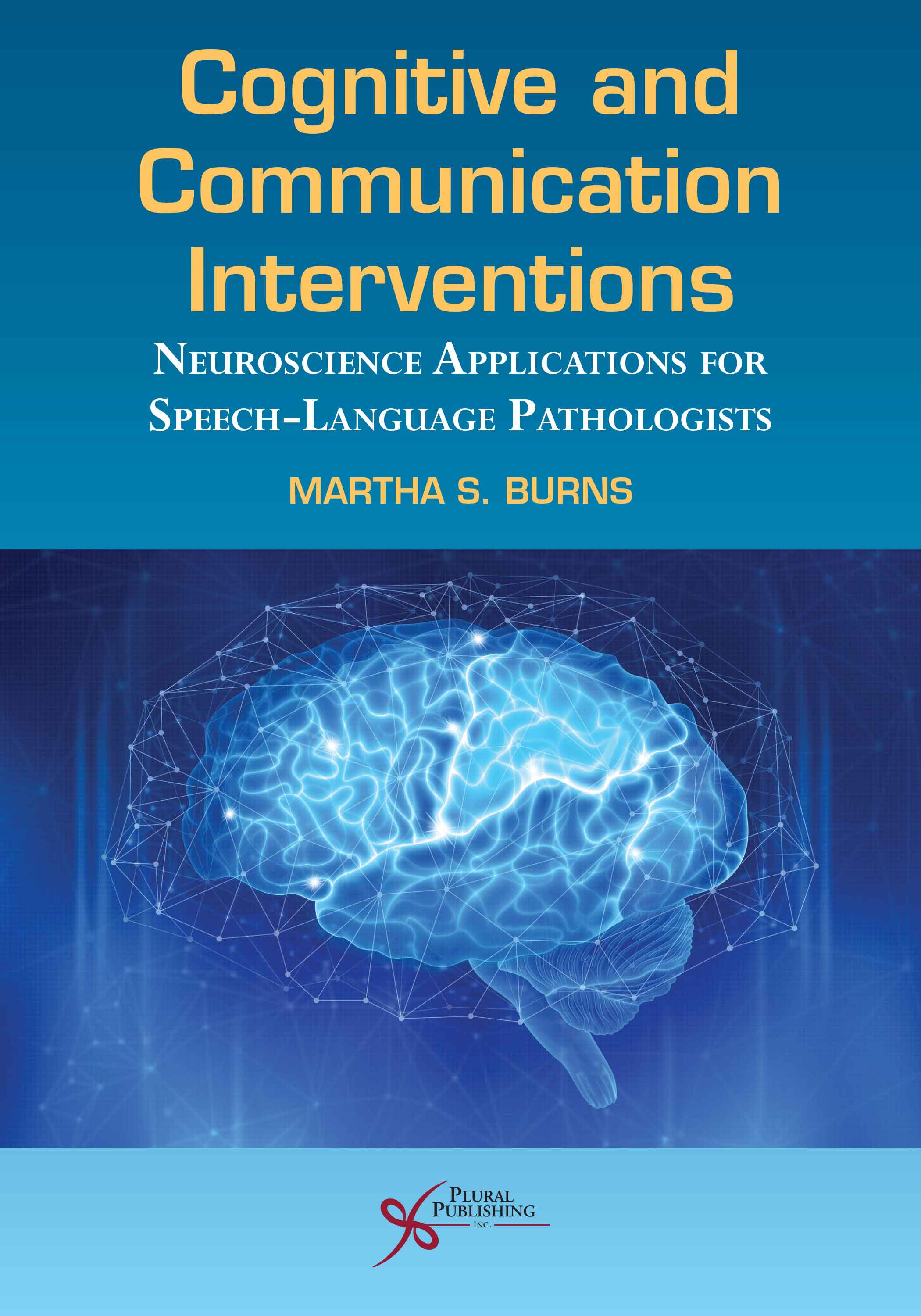
Cognitive and Communication Interventions: Neuroscience Applications for Speech-Language Pathologists
First Edition
Martha S. Burns
Details: 318 pages, B&W, Softcover, 7" x 10"
ISBN13: 978-1-63550-292-3
© 2021 | Available
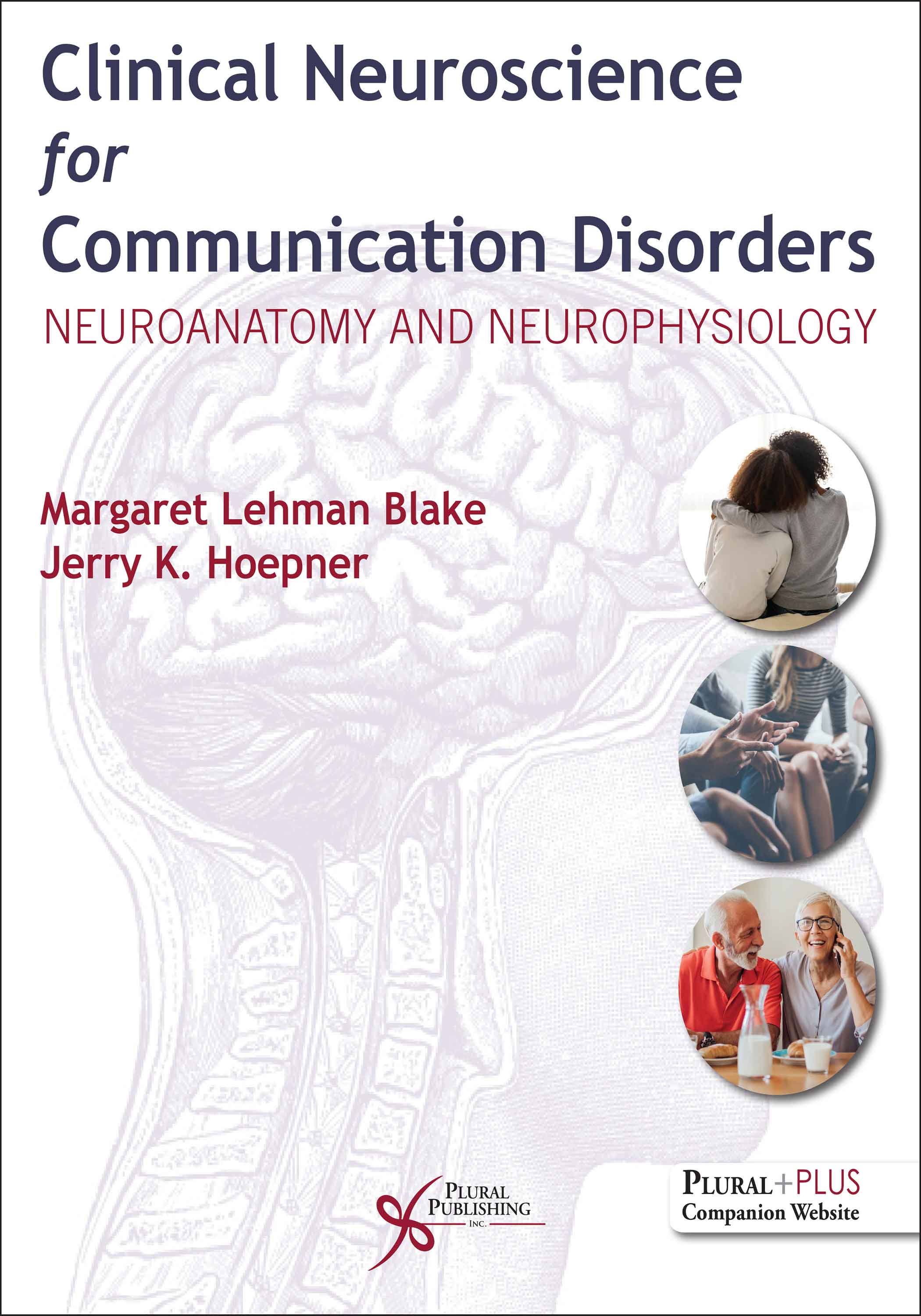
Clinical Neuroscience for Communication Disorders: Neuroanatomy and Neurophysiology.
First Edition
Margaret Lehman Blake, Jerry K. Hoepner
Details: 340 pages, Full Color, Hardcover, 8.5" x 11"
ISBN13: 978-1-63550-365-4
© 2023 | Available
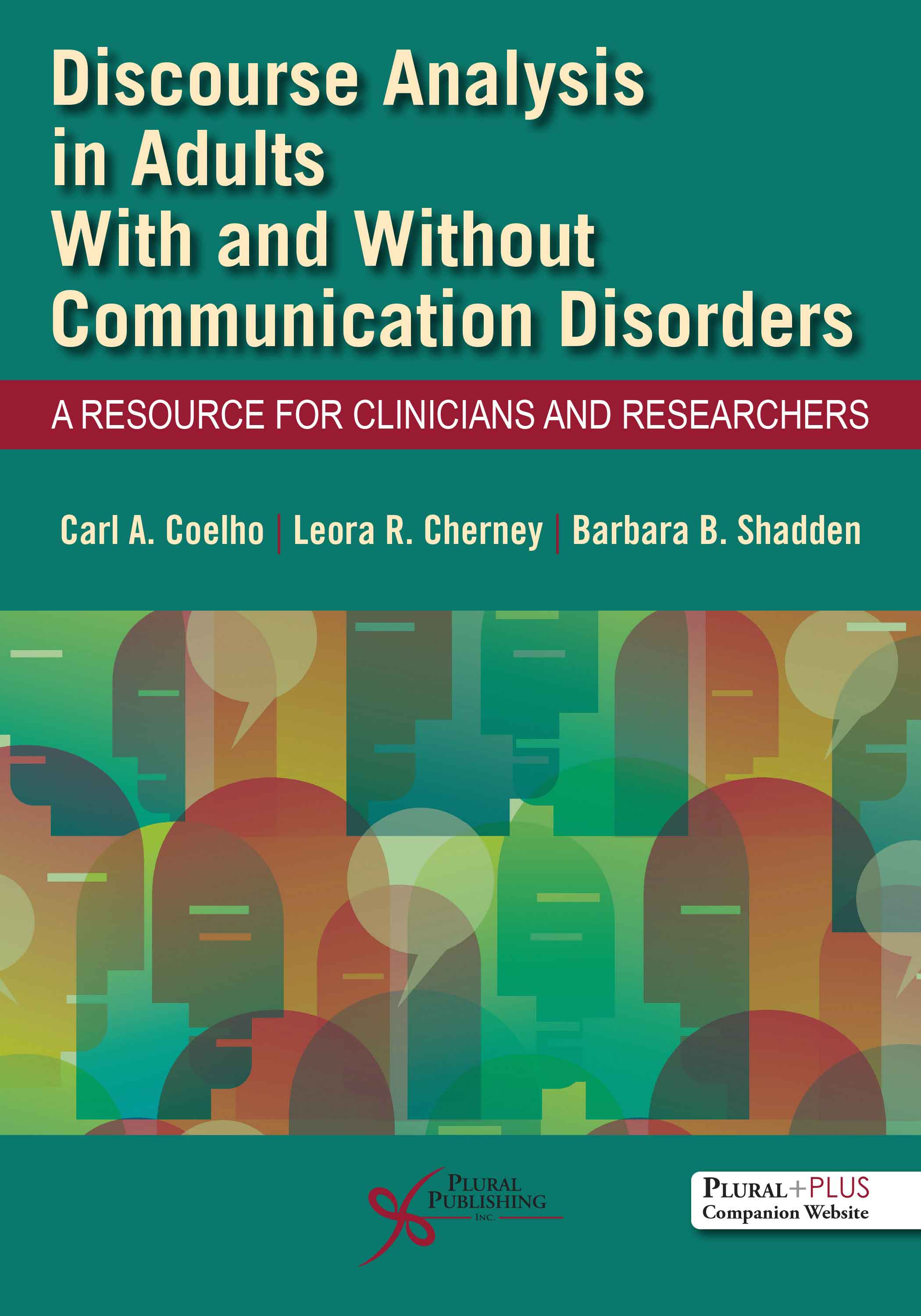
Discourse Analysis in Adults With and Without Communication Disorders: A Resource for Clinicians and Researchers
First Edition
Carl Coelho, Leora R. Cherney, Barbara B. Shadden
Details: 341 pages, B&W, Softcover, 7" x 10"
ISBN13: 978-1-63550-375-3
© 2023 | Available
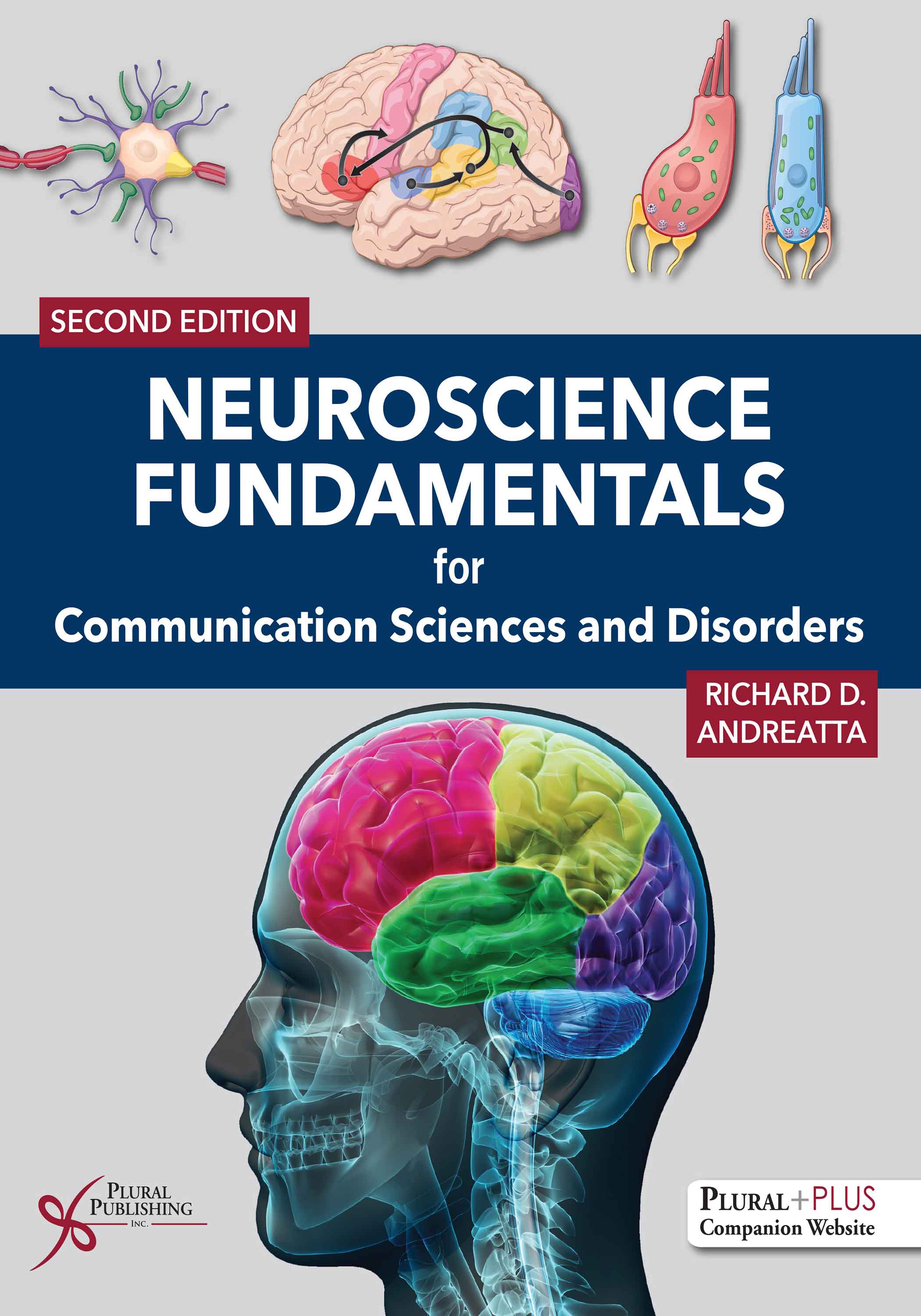
Neuroscience Fundamentals for Communication Sciences and Disorders
Second Edition
Richard D. Andreatta
Details: 802 pages, Full Color, Hardcover, 8.5" x 11"
ISBN13: 978-1-63550-359-3
© 2024 | Available
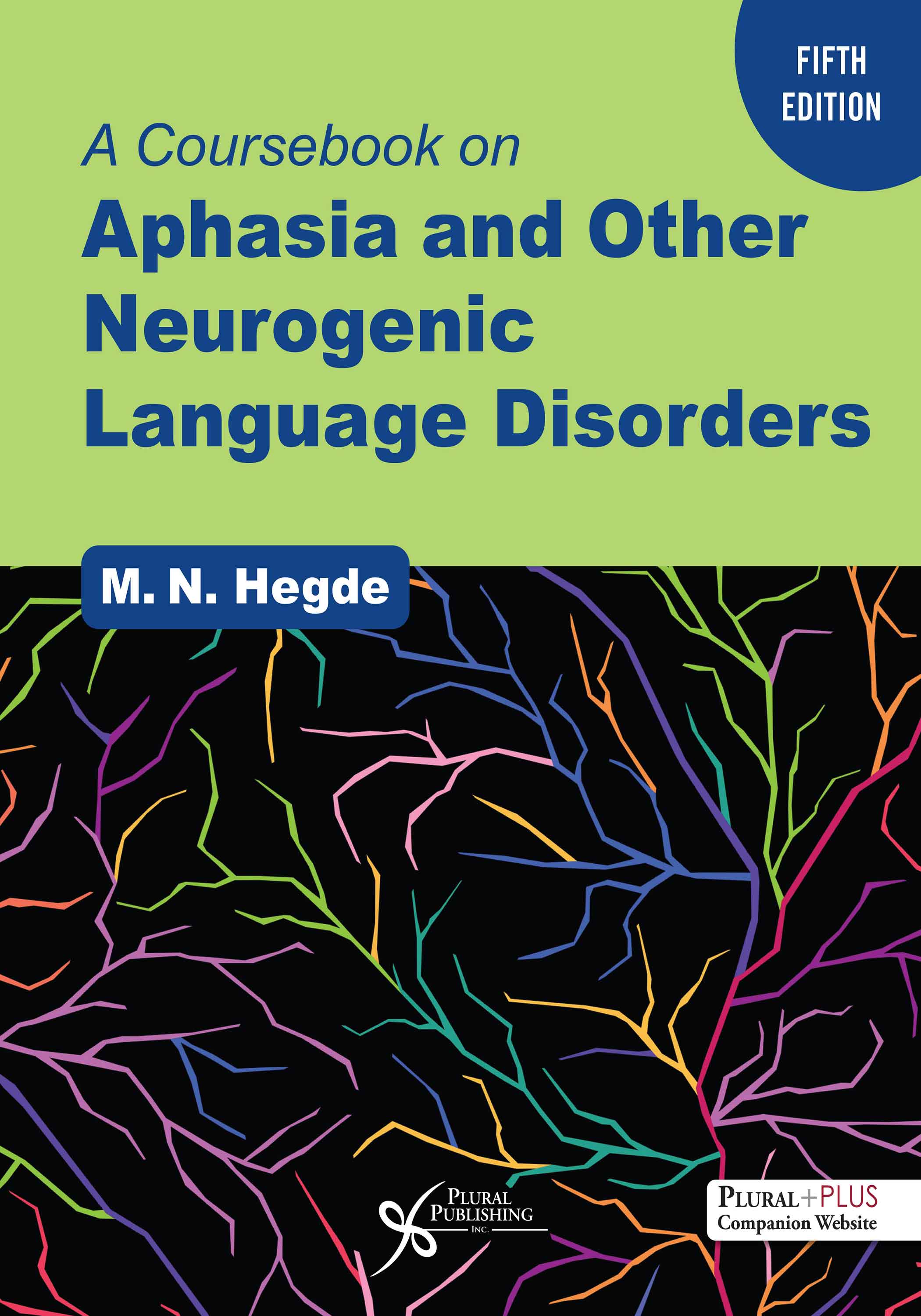
A Coursebook on Aphasia and Other Neurogenic Language Disorders
Fifth Edition
M.N. Hegde
Details: 426 pages, B&W, Spiral, 8.5" x 11"
ISBN13: 978-1-63550-422-4
© 2024 | Available
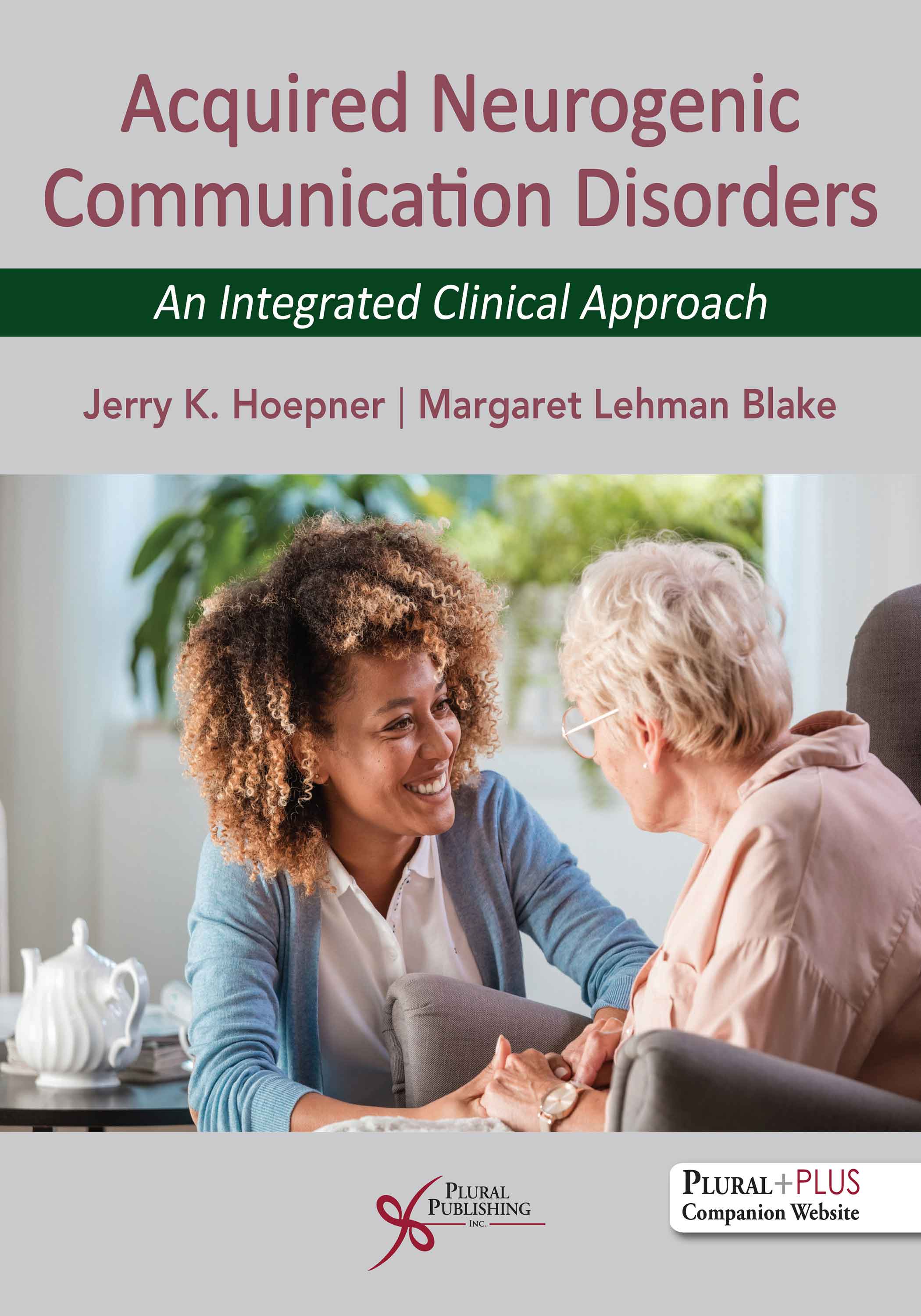
Acquired Neurogenic Communication Disorders: An Integrated Clinical Approach
First Edition
Jerry K. Hoepner, Margaret Lehman Blake
Details: 362 pages, Full Color, Softcover, 8.5" x 11"
ISBN13: 978-1-63550-425-5
© 2025 | Available
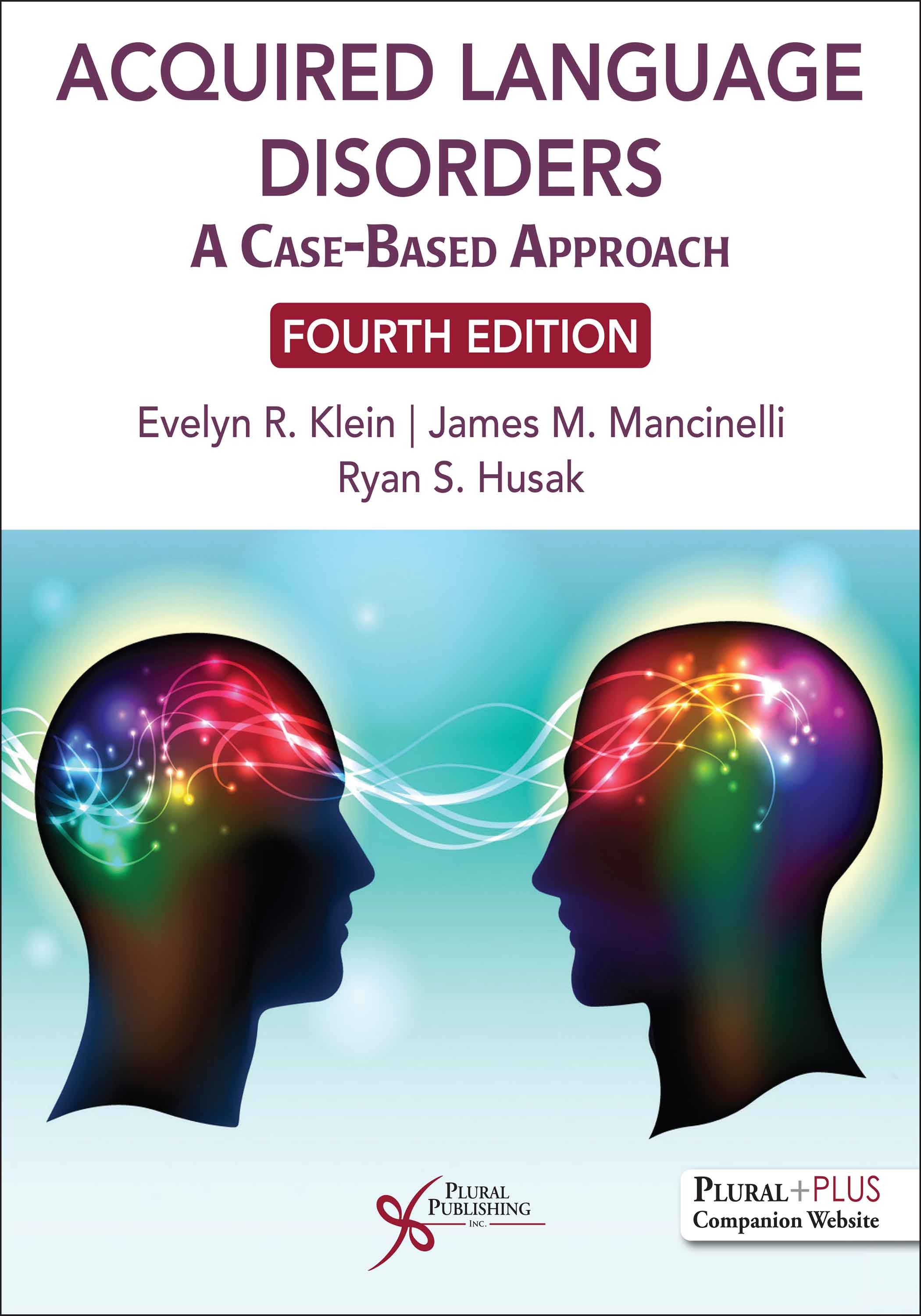
Acquired Language Disorders: A Case-Based Approach
Fourth Edition
Evelyn R. Klein, James M. Mancinelli, Ryan S. Husak
Details: 355 pages, B&W, Softcover, 8.5"x11"
ISBN13: 978-1-63550-700-3
© 2026 | Available
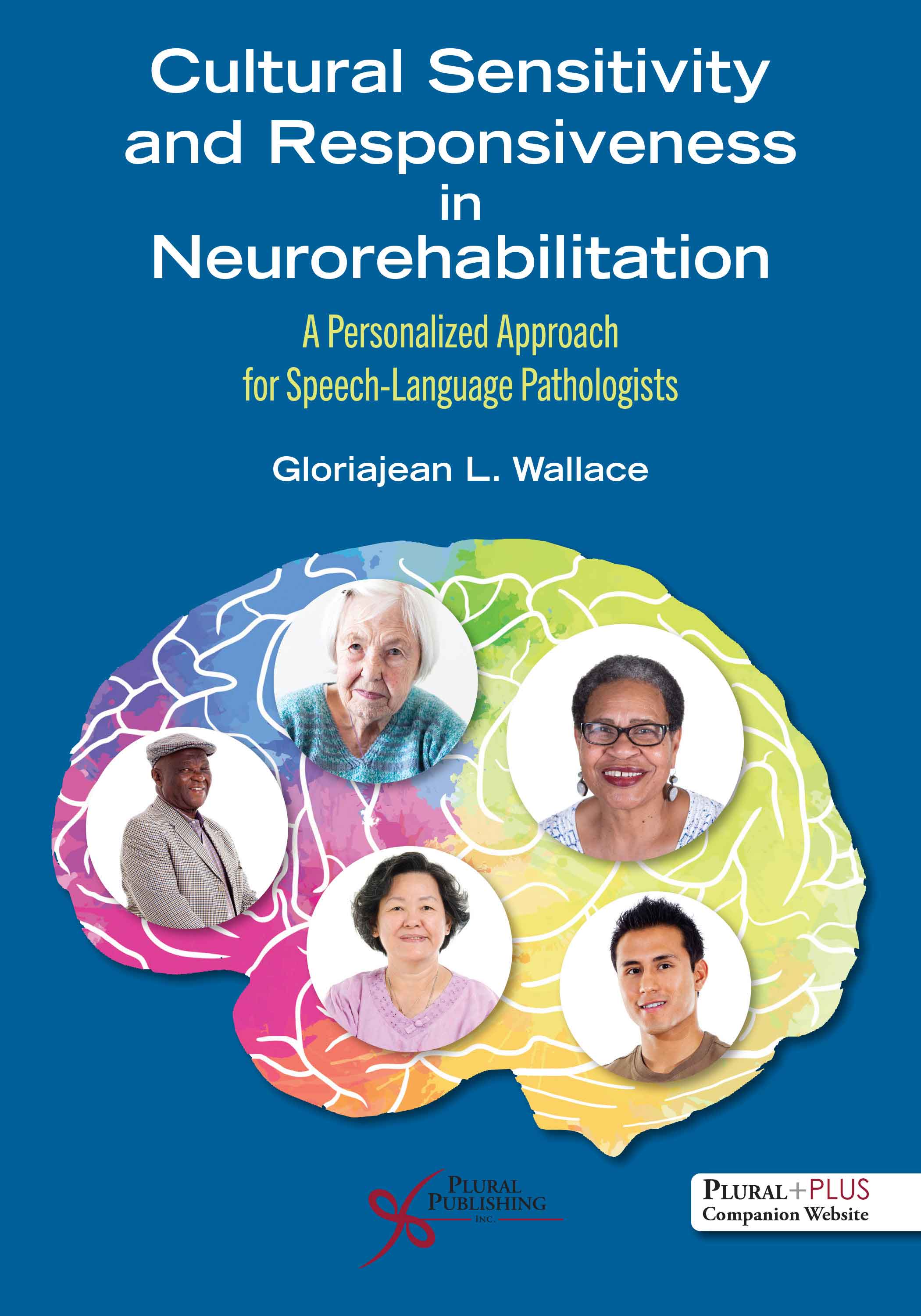
Cultural Sensitivity and Responsiveness in Neurorehabilitation: A Personalized Approach for Speech-Language Pathologists
First Edition
Gloriajean L. Wallace
Details: 853 pages, B&W, Softcover, 7" x 10"
ISBN13: 978-1-63550-032-5
© 2025 | Available

